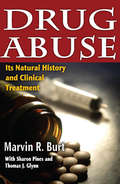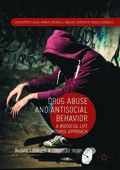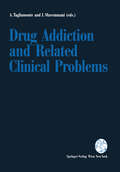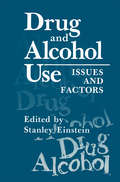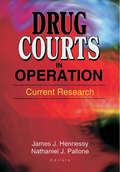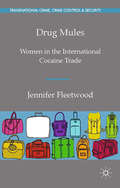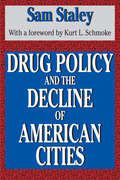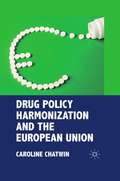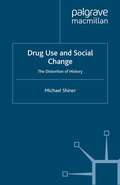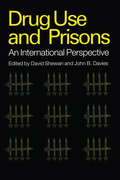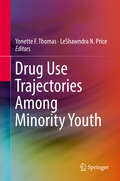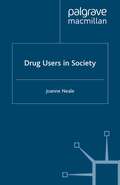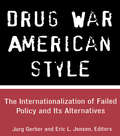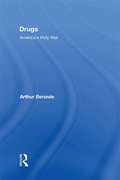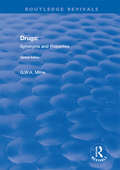- Table View
- List View
Drug Abuse: Its Natural History and Clinical Treatment
by Marvin R. Burt Sharon Pines Thomas J. GlynnThe success or failure of drug treatment programs have long been evaluated by assessing the clients' progress while in treatment and their status upon completion. This approach does not provide a complete assessment or an adequate picture of treatment outcomes over time. A comprehensive evaluation of the success or failure of treatment should also include client status in the years following treatment for a fair assessment of the long-term efficacy of any drug-treatment program. What happens to former clients who left treatment? What influence did the treatment have on their lives? These are the questions that Marvin R. Burt seeks to answer with the follow-up studies included in this book. By selecting samples of former clients treated by two of the largest drug treatment agencies in the U.S. and control groups, Burt compares client behavior in terms of drug abuse, criminal activity, and socioeconomic productivity before, immediately following, and well after treatment. The findings in this book challenge many common assumptions about drug treatment programs. Burt finds larger than expected positive behavioral changes in clients regardless of treatment duration or type, and demographic or background characteristics. Whether the results are attributable to the clients' maturation, commitment to change, or a reduction in the availability of drugs, the positive results of treatment are encouraging. This volume provides valuable insight into the natural history of drug abuse and outcomes for client groups.
Drug Abuse and Antisocial Behavior: A Biosocial Life Course Approach (Palgrave's Frontiers in Criminology Theory)
by Michael G. Vaughn Christopher P. Salas-Wright Jennifer M. Reingle GonzálezThis book is rooted in the conviction that human biology plays a critical role in understanding drug abuse and antisocial behavior. In the same breath, however, it fundamentally affirms the importance of the many social and environmental factors that influence our behavior across the life course. The study begins with an overview of the scope of the problem of drug abuse and crime, and an examination of how these problems often feed into one another. Building upon that foundation, the focus shifts to a review of cutting-edge research on the genetics and neurobiology of addiction and antisocial behavior across the developmental periods of childhood, adolescence, and adulthood. An exploration of the implications of a biosocial life course approach in terms of drug abuse prevention, and an examination of what lies ahead for drug abuse and criminological research conclude this detailed and timely book. Policy makers, practitioners and scholars of criminology and sociology will find this of particular interest.
Drug Addiction and Related Clinical Problems
by A. Tagliamonte and I. MaremmaniMany of the questions related to the treatment of drug addiction originate from the confusion that still characterizes this issue, even though biology is irreversibly changing our outlook on the physiology and psychopathology of the mind. In fact, prejudices stemming from the archaic concept of mind-body dualism are so difficult to eradicate that even a skilled psychiatrist may find it hard to distinguish a psychiatric symptom from a socially transgressive behavior. The dilemma becomes even more salient for drug addiction, since many of the substances which induce abuse and dependence are illegal, and their production, trade and use are forbidden by law. If the use of heroin is connoted as a crime, it may become controversial to recognize its chronic sequelae as a disease. Hence, withdrawal symptoms may alternatively be attributed to drug effects, or labelled as immoral attitudes arising from a vicious personality. However, the physician's judgement, which has to be merely instrumental at improving the patient's quality of life, should never be influenced by such complex setting. In fact, the only concern of the physician must be that of ascertaining the causes of symptoms and of removing them: if symptoms are induced by the toxic effect of a drug, he has to use the most effective antidote, and then proceed towards a detoxification; if they are due to withdrawal, a substitutive substance should be given initially. In the case of narcotics, substitutive therapy on a maintenance basis may become mandatory.
Drug and Alcohol Use: Issues and Factors
by Stanley EinsteinThis book is the outcome of the First International Congress on Drugs and Alcohol to be held in Israel. Both the conference and this volume grew out of the need to overcome the specious man-made barriers which continue to separate intervention plans and efforts in the broad field of substance use and misuse. This need demands that all of us become aware not only of the differences which may separate our concerns, but also of the similarities in our goals and endeavors. We are obligated to draw together toward a common effort for the common good. The conference was designed to facilitate the exploration ot generic ~ssues. This volume is designed to document a variety of factors which are basic to the defining, selection, planning, implementation, and evaluation of substance use and misuse intervention. This book is not a traditional proceedings volume. Because the needs of a listening audience are quite different from those of the solitary reader, and the roles of a workshop or plenary session participant are also dissimilar from those of the reader, not all of the Congress presentations are included, and the articles that are included have undergone major revi sions. Current intervention needs and options demand a broad spectrum of clearly defined roles for all who are or should be involved. Hence these issues, among others, served as guidelines in the preparation of the revised articles.
Drug Courts: In Theory and in Practice (Social Problems And Social Issues Ser. #14)
by Jr. NolanDrug courts offer offenders an intensive court-based treatment program as an alternative to the normal adjudication process. Begun in 1989, they have since spread dramatically throughout the United States. In this interdisciplinary examination of the expanding movement, a distinguished panel of legal practitioners and academics offers theoretical assessments and on-site empirical analyses of the workings of various courts in the United States, along with detailed comparisons and contrasts with related developments in Britain. Practitioners, politicians, and academics alike acknowledge the profound impact drug courts have had on the American criminal justice system. From a range of disciplinary perspectives, contributors to this volume seek to make sense of this important judicial innovation. While addressing a range of questions, Drug Courts also aims to achieve a careful balance between focused empirical studies and broader theoretical analyses of the same phenomenon. The volume maintains an analytical concentration on drug courts and on the important practical, philosophical, and jurisprudential consequences of this unique form of therapeutic jurisprudence.Drug courts depart from the practices and procedures of typical criminal courts. Prosecutors and defense counsel play much-reduced roles. Often lawyers are not even present during regular drug court sessions. Instead, the main courtroom drama is between the judge and client, both of whom speak openly and freely in the drug court setting. Often accompanying the client is a treatment provider who advises the judge and reviews the client's progress in treatment. Court sessions are characterized by expressive and sometimes tearful testimonies about the recovery process, and are often punctuated with applause from those in attendance. Taken together, the chapters provide a variety of perspectives on drug courts, and extend our knowledge of the birth and evolution of a new movement. Drug Courts<
Drug Courts: In Theory and in Practice
by Jr. NolanDrug courts offer offenders an intensive court-based treatment program as an alternative to the normal adjudication process. Begun in 1989, they have since spread dramatically throughout the United States. In this interdisciplinary examination of the expanding movement, a distinguished panel of legal practitioners and academics offers theoretical assessments and on-site empirical analyses of the workings of various courts in the United States, along with detailed comparisons and contrasts with related developments in Britain. Practitioners, politicians, and academics alike acknowledge the profound impact drug courts have had on the American criminal justice system. From a range of disciplinary perspectives, contributors to this volume seek to make sense of this important judicial innovation. While addressing a range of questions, Drug Courts also aims to achieve a careful balance between focused empirical studies and broader theoretical analyses of the same phenomenon. The volume maintains an analytical concentration on drug courts and on the important practical, philosophical, and jurisprudential consequences of this unique form of therapeutic jurisprudence.Drug courts depart from the practices and procedures of typical criminal courts. Prosecutors and defense counsel play much-reduced roles. Often lawyers are not even present during regular drug court sessions. Instead, the main courtroom drama is between the judge and client, both of whom speak openly and freely in the drug court setting. Often accompanying the client is a treatment provider who advises the judge and reviews the client's progress in treatment. Court sessions are characterized by expressive and sometimes tearful testimonies about the recovery process, and are often punctuated with applause from those in attendance. Taken together, the chapters provide a variety of perspectives on drug courts, and extend our knowledge of the birth and evolution of a new movement. Drug Courts<
Drug Courts in Operation: Current Research
by James Joseph HennessyExamine an innovative strategy for fighting the war on drugs!Drug Courts in Operation: Current Research provides an in-depth look at an increasingly utilized approach to rehabilitating substance abusers. Drug courts offer their participants a chance to better themselves by providing support and structure to those that do not have it in their life, offering substance abusers a chance to participate in rehabilitation in lieu of incarceration. This insightful book examines the history of drug courts as a principal treatment alternative to incarceration, outlines the risk factors of children living with drug-addicted parents, and introduces a program to help strengthen families.The book delivers vital information on: introducing programs to help prevent narcotic use by children with drug-addicted parents the need for cultural- and gender-specific treatment plans, especially in the treatment of women and African-American males treatment dosage effects the importance of length of participation to outcomes focus groups designed to help drug court participants with their employment needs predictors of engagement in court-mandated treatment programs how legal coercion of high-risk patients via the threat of incarceration motivates participants to succeed
Drug Courts in Operation: Current Research
by James Joseph HennessyExamine an innovative strategy for fighting the war on drugs!Drug Courts in Operation: Current Research provides an in-depth look at an increasingly utilized approach to rehabilitating substance abusers. Drug courts offer their participants a chance to better themselves by providing support and structure to those that do not have it in their life, offering substance abusers a chance to participate in rehabilitation in lieu of incarceration. This insightful book examines the history of drug courts as a principal treatment alternative to incarceration, outlines the risk factors of children living with drug-addicted parents, and introduces a program to help strengthen families.The book delivers vital information on: introducing programs to help prevent narcotic use by children with drug-addicted parents the need for cultural- and gender-specific treatment plans, especially in the treatment of women and African-American males treatment dosage effects the importance of length of participation to outcomes focus groups designed to help drug court participants with their employment needs predictors of engagement in court-mandated treatment programs how legal coercion of high-risk patients via the threat of incarceration motivates participants to succeed
Drug Mules: Women in the International Cocaine Trade (Transnational Crime, Crime Control and Security)
by J. FleetwoodWinner of the British Society of Criminology Book Prize, 2015Fleetwood explores how women become involved in trafficking, focusing on the lived experiences of women as drug mules. Offering theoretical insights from gender theory and transnational criminology, Fleetwood argues that women's participation in the drugs trade cannot be adequately understood through the lenses of either victimization or agency.
Drug Policy
by Alison RitterTaking a multidisciplinary perspective (including public health, sociology, criminology, and political science amongst others) and using examples from across the globe, this book provides a detailed understanding of the complex and highly contested nature of drug policy, drug policy making, and the theoretical perspectives that inform the study of drug policy. It draws on four different theoretical perspectives: evidence-informed policy, policy process theories, democratic theory, and post-structural policy analysis. The use and trade in illegal drugs is a global phenomenon. It is viewed by governments as a significant social, legal, and health problem that shows no signs of abating. The key questions explored throughout this book are what governments and other bodies of social regulation should do about illicit drugs, including drug policies aimed at improving health and reducing harm, drug laws and regulation, and the role of research and values in policy development. Seeing policy formation as dynamic iterative interactions between actors, ideas, institutions, and networks of policy advocates, the book explores how policy problems are constructed and policy solutions selected, and how these processes intersect with research evidence and values. This then animates the call to democratise drug policy and bring about inclusive meaningful participation in policy development in order to provide the opportunity for better, more effective, and value-aligned drug policies. This book will be of great interest to students and scholars of drug policy from a number of disciplines, including public health, sociology, criminology, and political science.
Drug Policy
by Alison RitterTaking a multidisciplinary perspective (including public health, sociology, criminology, and political science amongst others) and using examples from across the globe, this book provides a detailed understanding of the complex and highly contested nature of drug policy, drug policy making, and the theoretical perspectives that inform the study of drug policy. It draws on four different theoretical perspectives: evidence-informed policy, policy process theories, democratic theory, and post-structural policy analysis. The use and trade in illegal drugs is a global phenomenon. It is viewed by governments as a significant social, legal, and health problem that shows no signs of abating. The key questions explored throughout this book are what governments and other bodies of social regulation should do about illicit drugs, including drug policies aimed at improving health and reducing harm, drug laws and regulation, and the role of research and values in policy development. Seeing policy formation as dynamic iterative interactions between actors, ideas, institutions, and networks of policy advocates, the book explores how policy problems are constructed and policy solutions selected, and how these processes intersect with research evidence and values. This then animates the call to democratise drug policy and bring about inclusive meaningful participation in policy development in order to provide the opportunity for better, more effective, and value-aligned drug policies. This book will be of great interest to students and scholars of drug policy from a number of disciplines, including public health, sociology, criminology, and political science.
Drug Policy and the Decline of the American City
by Sam StaleyThe drug trade is a growth industry in most major American cities, fueling devastated inner-city economies with revenues in excess of $100 billion. In this timely volume, Sam Staley provides a detailed, in-depth analysis of the consequences of current drug policies, focusing on the relationship between public policy and urban economic development and on how the drug economy has become thoroughly entwined in the urban economy. The black market in illegal drugs undermines essential institutions necessary for promoting long-term economic growth, including respect for civil liberties, private property, and nonviolent conflict resolution. Staley argues that America's cities can be revitalized only through a major restructuring of the urban economy that does not rely on drug trafficking as a primary source of employment and income-the inadvertent outcome of current prohibitionist policy. Thus comprehensive decriminalization of the major drugs (marijuana, cocaine, and heroin) is an important first step toward addressing the economic and social needs of depressed inner cities. Staley demonstrates how decriminalization would refocus public policy on the human dimension of drug abuse and addiction, acknowledge that the cities face severe development problems that promote underground economic activity, and reconstitute drug policy on principles consistent with limited government as embodied in the U.S. Constitution and Bill of Rights. Designed to cross disciplinary boundaries, Staley's provocative analysis will be essential reading for urban policymakers, sociologists, economists, criminologists, and drug-treatment specialists.
Drug Policy and the Decline of the American City
by Sam StaleyThe drug trade is a growth industry in most major American cities, fueling devastated inner-city economies with revenues in excess of $100 billion. In this timely volume, Sam Staley provides a detailed, in-depth analysis of the consequences of current drug policies, focusing on the relationship between public policy and urban economic development and on how the drug economy has become thoroughly entwined in the urban economy. The black market in illegal drugs undermines essential institutions necessary for promoting long-term economic growth, including respect for civil liberties, private property, and nonviolent conflict resolution. Staley argues that America's cities can be revitalized only through a major restructuring of the urban economy that does not rely on drug trafficking as a primary source of employment and income-the inadvertent outcome of current prohibitionist policy. Thus comprehensive decriminalization of the major drugs (marijuana, cocaine, and heroin) is an important first step toward addressing the economic and social needs of depressed inner cities. Staley demonstrates how decriminalization would refocus public policy on the human dimension of drug abuse and addiction, acknowledge that the cities face severe development problems that promote underground economic activity, and reconstitute drug policy on principles consistent with limited government as embodied in the U.S. Constitution and Bill of Rights. Designed to cross disciplinary boundaries, Staley's provocative analysis will be essential reading for urban policymakers, sociologists, economists, criminologists, and drug-treatment specialists.
Drug Policy Harmonization and the European Union
by C. ChatwinExploring the illegal drug issue in international context, this book looks at why harmonization has not already taken place at the European level. It considers the desirability and viability of harmonization, examines the conflict between repressive and liberal drug policies and applies a multi-level governance lens to the issue.
Drug Use and Social Change: The Distortion of History
by M. ShinerThis book locates the rise of illicit drug use within the historical development of late industrial society and challenges the prevailing view. Highlighting key areas of continuity and the on-going value of classic criminological theory, it is argued that recent trends do not constitute the radical departure that is often supposed.
Drug Use in Prisons
by ShewanFirst Published in 2000. Routledge is an imprint of Taylor & Francis, an informa company.
Drug Use in Prisons (Scottish Prison Service Occasional Paper Ser.)
by ShewanFirst Published in 2000. Routledge is an imprint of Taylor & Francis, an informa company.
Drug Use Trajectories Among Minority Youth
by Yonette F. Thomas LeShawndra N. PriceThis volume examines trajectories of drug use among ethnic minority youth in the United States with a focus on African Americans and Hispanics. It also highlights what research designs have been employed to address these differences as well as suggests strategies for moving this discourse forward by identifying potential targets for prevention and intervention with minority youth. This book features essays by leading experts in the field who have grappled with this issue for decades. Inside, readers will find an insightful dialogue that addresses such questions as: Why are African American and Hispanic youth more likely than their White peers to abstain from drug use during adolescence but are more likely to become problem users later in life? What impact does the stress caused by discrimination have on potential drug use? To what extent does religiosity protect minority youth from drug use as past research suggests that it protects White youth? What is the influence of neighborhood context on exposure to and use of substances among urban African American children? Taken together, the essays in this book identify underexplored risk and protective factors and gaps in the current state of knowledge that can be used to develop effective, culturally specific drug abuse prevention strategies. This book is for anyone with an interest in the initiation and escalation of drug use among African Americans and Hispanics/Latinos and factors that influence these patterns over the life course. It will also be an ideal resource for those interested in better understanding the mechanisms by which risk and protective factors are related to the development of drug use and addiction, particularly the ways in which such factors contribute to health differences and have disproportionately more negative consequences for ethnic minorities.
Drug Users in Society
by Joanne NealeThis book provides a candid insight into the lives of individuals who are addicted to heroin and other opiates. The processes of obtaining and using drugs are explored within the wider context of personal biographies and daily routines. Key issues considered include childhood experiences, crime and violence, housing situations, family relationships, prison life, health matters and drug treatments. Drug users' statements are related to policy, service provision, previous research, and theoretical debates in the hope that this might increase understanding and improve future responses to drug problems.
Drug War American Style: The Internationalization of Failed Policy and its Alternatives (Current Issues in Criminal Justice)
by Jurg Gerber Eric L. JensenThis collection of scholarly essays discusses the internationalization of American drug policy from a variety of perspectives and features articles on Hong Kong, Britain, Australia, Canada, Taiwan, Latin America, the Netherlands and Switzerland.
Drug War American Style: The Internationalization of Failed Policy and its Alternatives (Current Issues in Criminal Justice #26)
by Jurg Gerber Eric L. JensenThis collection of scholarly essays discusses the internationalization of American drug policy from a variety of perspectives and features articles on Hong Kong, Britain, Australia, Canada, Taiwan, Latin America, the Netherlands and Switzerland.
Drugs: America's Holy War
by Arthur BenavieUsing the best scientific evidence, Drugs: America's Holy War explores the impact and cost of America’s "War on Drugs" – both in tax spending and in human terms. Is it possible that US drug policies are helping to proliferate, not prevent, a multitude of social ills including: homicide, property crime, the spread of AIDS, the contamination of drugs, the erosion of civil liberties, the punishment of thousands of non-violent people, the corruption of public officials, and the spending of billions of tax dollars in an attempt to prevent certain drugs from entering the country? In this controversial new book, award-winning economist Arthur Benavie analyzes the research findings and argues that an end to the war on drugs, much as we ended alcohol prohibition, would yield enormous international benefits, destroy dangerous and illegal drug cartels, and allow the American government to refocus its attention on public well-being.
Drugs: America's Holy War
by Arthur BenavieUsing the best scientific evidence, Drugs: America's Holy War explores the impact and cost of America’s "War on Drugs" – both in tax spending and in human terms. Is it possible that US drug policies are helping to proliferate, not prevent, a multitude of social ills including: homicide, property crime, the spread of AIDS, the contamination of drugs, the erosion of civil liberties, the punishment of thousands of non-violent people, the corruption of public officials, and the spending of billions of tax dollars in an attempt to prevent certain drugs from entering the country? In this controversial new book, award-winning economist Arthur Benavie analyzes the research findings and argues that an end to the war on drugs, much as we ended alcohol prohibition, would yield enormous international benefits, destroy dangerous and illegal drug cartels, and allow the American government to refocus its attention on public well-being.
Drugs: Policy And Politics (UK Higher Education OUP Humanities & Social Sciences Sociology)
by Paul Higate Rhidian Hughes Rachel LartDrugs: Policy and Politics is an accessible introduction to the links between drugs and social policy. Assessing current and recent policies and political responses, it considers the ways in which drugs policy is formulated and implemented in the UK and Europe.The book examines the dynamic context of drug policy through discussions of broader policy fields such as health and the criminal justice system. The contributors offer evidence-based insights into the social complexities of both drug use and drug users, as they examine those specific groups who are associated with particular patterns of drug use. Drug issues are linked with aspects of gender, race and social exclusion, all of which have a resonance in the current discourses of policy making. Drugs: Policy and Politics provides an important set of tools with which to rethink the diversity of drug use and drug users. It is important reading for social policy students and researchers, as well as trainee social workers, probation officers, police and prison officers.
Drugs: Synonyms and Properties (Routledge Revivals)
by G W MilneThis title was first published in 2002: Drugs: Synonyms and Properties provides comprehensive coverage of the 10,000 drugs currently in common use worldwide. Its overall organization and inclusion of detailed chemical information fills an important gap in drug information. This reference, edited by a world–renowned authority in drug design and chemical information and now in its second edition, has become one of the bibles of pharmaceutical research and application. This book organizes the 10,000 drugs currently in use by therapeutic category. Therefore all tranquilizers, all antidepressants, or all anorexic agents, for example, are grouped together. In all, 204 categories are represented. This arrangement means that all drugs in a given category can be reviewed very easily and their relative properties compared quickly. A key component of this reference is the extensive coverage of synonyms. The book includes an index of over 30,000 drug synonyms and trade names with a cross–reference to their main entry. This extraordinarily comprehensive view of trade names and generic synonyms makes Drugs: Synonyms and Properties one of the world′s most exhaustive references in its field. For each main entry, the following information is provided: chemical name and a list of trade names and synonyms; the Chemical Abstracts Service (CAS) Registry Number; the European Inventory of Existing Commercial Chemical Substances (EINECS) Number; the Merck Index (Twelfth Edition) Number; the physical properties of each compound; and the known biological activity and indicated applications. Indexes, including a master index of names and synonyms, and of manufacturers and suppliers, are appended. This reference will be invaluable to research chemists, biologists, and physicians and to anyone interested in drugs who, starting with a single synonym for a drug, will be able to quickly find a thumbnail sketch of the essential information concerning that agent.
